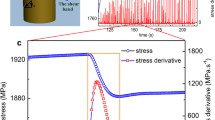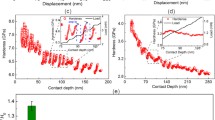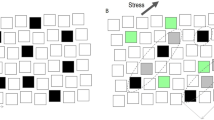Abstract
In metallic glasses, a high Poisson’s ratio often corresponds to a large plasticity and ductility. Yet the physics underpinning such a connection is still poorly understood. Here through finite element simulations, we reveal that a high Poisson’s ratio could promote the inhomogeneous stress distribution in metallic glasses. The inhomogeneous stress field could cause earlier nucleation and easier arrest of shear bands, and therefore better plasticity. Experimental results also show a trend of decreasing shear limit with Poisson’s ratio. These findings suggest that the stress inhomogeneity might be a key to understand the effects of Poisson’s ratio and loading condition on the plastic deformation behaviors of metallic glasses.





Similar content being viewed by others
References
Sha ZD, He LC, Xu S et al (2014) Effect of aspect ratio on the mechanical properties of metallic glasses. Scr Mater 93:36–39
Mondal K, Hono K (2009) Geometry constrained plasticity of bulk metallic glass. Mater Trans 50:152–157
Schuh CA, Hufnagel TC, Ramamurty U (2007) Mechanical behavior of amorphous alloys. Acta Mater 55:4067–4109
Wu FF, Zheng W, Wu SD, Zhang ZF, Shen J (2011) Shear stability of metallic glasses. Int J Plast 27:560–575
Yoo BG, Kim JY, Kim YJ et al (2012) Increased time-dependent room temperature plasticity in metallic glass nanopillars and its size-dependency. Int J Plast 37:108–118
Jang DC, Gross CT, Greer JR (2011) Effects of size on the strength and deformation mechanism in Zr-based metallic glasses. Int J Plast 27:858–867
Yao ZF, Qiao JC, Liu Y, Pelletier JM, Yao Y (2017) Aspect ratio effects on the serration dynamics of a Zr-based bulk metallic glass. J Mater Sci 52:138–144. doi:10.1007/s10853-016-0316-7
Nakayama KS, Yokoyama Y, Ono T et al (2010) Controlled formation and mechanical characterization of metallic glassy nanowires. Adv Mater 22:872–875
Volkert CA, Donohue A, Spaepen F (2008) Effect of sample size on deformation in amorphous metals. J Appl Phys 103:083539
Jang D, Greer JR (2010) Transition from a strong-yet-brittle to a stronger-and-ductile state by size reduction of metallic glasses. Nat Mater 9:215–219
Lewandowski JJ, Wang WH, Greer AL (2005) Intrinsic plasticity or brittleness of metallic glasses. Philos Mag Lett 85:77–87
Schroers J, Johnson WL (2004) Ductile bulk metallic glass. Phys Rev Lett 93:255506
Madge S, Louzguine-Luzgin D, Lewandowski J, Greer A (2012) Toughness, extrinsic effects and Poisson’s ratio of bulk metallic glasses. Acta Mater 60:4800–4809
Sun BA, Wang WH (2015) The fracture of bulk metallic glasses. Prog Mater Sci 74:211–307
Jiang M, Dai L (2007) Intrinsic correlation between fragility and bulk modulus in metallic glasses. Phys Rev B 76:054204
Greaves GN, Sen S (2007) Inorganic glasses, glass-forming liquids and amorphizing solids. Adv Phys 56:1–166
Johnson WL, Samwer K (2005) A universal criterion for plastic yielding of metallic glasses with a (T/T g)2/3 temperature dependence. Phys Rev Lett 95:195501
Ngai KL, Wang LM, Liu R, Wang WH (2014) Microscopic dynamics perspective on the relationship between Poisson’s ratio and ductility of metallic glasses. J Chem Phys 140:044511
Wang Z, Ngai KL, Wang WH (2015) Understanding the changes in ductility and Poisson’s ratio of metallic glasses during annealing from microscopic dynamics. J Appl Phys 118:034901
Baricco M, Baser TA, Das J, Eckert J (2009) Correlation between Poisson ratio and Mohr–Coulomb coefficient in metallic glasses. J Alloys Compd 483:125–131
Greaves GN, Greer A, Lakes R, Rouxel T (2011) Poisson’s ratio and modern materials. Nat Mater 10:823–837
Argon AS (1979) Plastic deformation in metallic glasses. Acta Metall 27:47–58
Schall P, Weitz DA, Spaepen F (2007) Structural rearrangements that govern flow in colloidal glasses. Science 318:1895–1899
Delogu F (2008) Identification and characterization of potential shear transformation zones in metallic glasses. Phys Rev Lett 100:255901
Greer AL, Cheng YQ, Ma E (2013) Shear bands in metallic glasses. Mater Sci Eng R 74:71–132
Demetriou MD, Launey ME, Garrett G et al (2011) A damage-tolerant glass. Nat Mater 10:123–128
Sun BA, Hu YC, Wang DP et al (2016) Correlation between local elastic heterogeneities and overall elastic properties in metallic glasses. Acta Mater 121:266–276
Cheng YQ, Han Z, Li Y, Ma E (2009) Cold versus hot shear banding in bulk metallic glass. Phys Rev B 80:134115
Wright WJ, Samale MW, Hufnagel TC, LeBlanc MM, Florando JN (2009) Studies of shear band velocity using spatially and temporally resolved measurements of strain during quasistatic compression of a bulk metallic glass. Acta Mater 57:4639–4648
Klaumünzer D, Maaß R, Löffler JF (2011) Stick-slip dynamics and recent insights into shear banding in metallic glasses. J Mater Res 26:1453–1463
Wang Z, Qiao JW, Yang HJ, Liaw PK, Huang CJ, Li LF (2015) Serration dynamics in a Zr-based bulk metallic glass. Metall Mater Trans A 46A:2404–2414
Sun BA, Pauly S, Tan J et al (2012) Serrated flow and stick–slip deformation dynamics in the presence of shear-band interactions for a Zr-based metallic glass. Acta Mater 60:4160–4171
Song SX, Nieh TG (2011) Direct measurements of shear band propagation in metallic glasses—an overview. Intermetallics 19:1968–1977
Jiang MQ, Dai LH (2010) Short-range-order effects on intrinsic plasticity of metallic glasses. Philos Mag Lett 90:269–277
Zhang ZF, Zhang H, Pan XF, Das J, Eckert J (2005) Effect of aspect ratio on the compressive deformation and fracture behaviour of Zr-based bulk metallic glass. Philos Mag Lett 85:513–521
Wu FF, Zhang ZF, Mao SX (2007) Compressive properties of bulk metallic glass with small aspect ratio. J Mater Res 22:501–507
Hofmann DC, Suh JY, Wiest A et al (2008) Designing metallic glass matrix composites with high toughness and tensile ductility. Nature 451:1085–1089
Qiao JW, Zhang Y, Jia HL, Yang HJ, Liaw PK, Xu BS (2012) Tensile softening of metallic-glass-matrix composites in the supercooled liquid region. Appl Phys Lett 100:121902
Pauly S, Gorantla S, Wang G, Kühn U, Eckert J (2010) Transformation-mediated ductility in CuZr-based bulk metallic glasses. Nat Mater 9:473–477
Saida J, Setyawan ADH, Kato H, Inoue A (2005) Nanoscale multistep shear band formation by deformation-induced nanocrystallization in Zr–Al–Ni–Pd bulk metallic glass. Appl Phys Lett 87:151907
Yao KF, Ruan F, Yang YQ, Chen N (2006) Superductile bulk metallic glass. Appl Phys Lett 88:122106
Du XH, Huang JC, Hsieh KC et al (2007) Two-glassy-phase bulk metallic glass with remarkable plasticity. Appl Phys Lett 91:131901
Chen W, Chan KC, Chen SH, Guo SF, Li WH, Wang G (2012) Plasticity enhancement of a Zr-based bulk metallic glass by an electroplated Cu/Ni bilayered coating. Mater Sci Eng A 552:199–203
Harms U, Jin O, Schwarz RB (2003) Effects of plastic deformation on the elastic modulus and density of bulk amorphous Pd40Ni10Cu30P20. J Non Cryst Solids 317:200–205
Zhang Y, Zhao DQ, Wang RJ, Wang WH (2003) Formation and properties of Zr48Nb8Cu14Ni12Be18 bulk metallic glass. Acta Mater 51:1971–1979
Golding B, Hsu FSL, Bagley BG (1972) Soft transverse phonons in a metallic glass. Phys Rev Lett 29:68–70
Davis LA, Kavesh S (1975) Deformation and fracture of an amorphous metallic alloy at high pressure. J Mater Sci 10:453–459. doi:10.1007/BF00543690
Schroers J, Lohwongwatana B, Johnson WL, Peker A (2005) Gold based bulk metallic glass. Appl Phys Lett 87:061912
Chen HS, Krause JT, Coleman E (1975) Elastic constants, hardness and their implications to flow properties of metallic glasses. J Non Cryst Solids 18:157–171
Ponnambalam V, Poon SJ, Shiflet GJ (2004) Fe–Mn–Cr–Mo–(Y, Ln)–C–B (Ln = lanthanides) bulk metallic glasses as formable amorphous steel alloys. J Mater Res 19:3046–3052
Donovan PE (1989) A yield criterion for Pd40Ni40P20 metallic glass. Acta Metall 37:445–456
Xu DH, Duan G, Johnson WL, Garland C (2004) Formation and properties of new Ni-based amorphous alloys with critical casting thickness up to 5 mm. Acta Mater 52:3493–3497
Choi-Yim H, Xu DH, Johnson WL (2003) Ni-based bulk metallic glass formation in the Ni–Nb–Sn and Ni–Nb–Sn–X (X = B, Fe, Cu) alloy systems. Appl Phys Lett 82:1030–1032
Lewandowski JJ, Lowhaphandu P (2002) Effects of hydrostatic pressure on the flow and fracture of a bulk amorphous metal. Philos Mag A 82:3427–3441
Wright WJ, Saha R, Nix WD (2001) Deformation mechanisms of the Zr40Ti14Ni10Cu12Be24 bulk metallic glass. Mater Trans 42:642–649
Subhash G, Dowding RJ, Kecskes LJ (2002) Characterization of uniaxial compressive response of bulk amorphous Zr–Ti–Cu–Ni–Be alloy. Mater Sci Eng A 334:33–40
Keryvin V, Vaillant ML, Rouxel T, Huger M, Gloriant T, Kawamura Y (2002) Thermal stability and crystallisation of a Zr55Cu30Al10Ni5 bulk metallic glass studied by in situ ultrasonic echography. Intermetallics 10:1289–1296
Conner RD, Li Y, Nix WD, Johnson WL (2004) Shear band spacing under bending of Zr-based metallic glass plates. Acta Mater 52:2429–2434
Xu DH, Duan G, Johnson WL (2004) Unusual glass-forming ability of bulk amorphous alloys based on ordinary metal copper. Phys Rev Lett 92:245504
Duan G, Xu DH, Zhang Q et al (2005) Molecular dynamics study of the binary Cu46Zr54 metallic glass motivated by experiments: glass formation and atomic-level structure. Phys Rev B 71:224208
Inoue A, Zhang W, Zhang T, Kurosaka K (2001) High-strength Cu-based bulk glassy alloys in Cu–Zr–Ti and Cu–Hf–Ti ternary systems. Acta Mater 49:2645–2652
Xu DH, Lohwongwatana B, Duan G, Johnson WL, Garland C (2004) Bulk metallic glass formation in binary Cu-rich alloy series—Cu100–xZrx (x = 34, 36 38.2, 40 at.%) and mechanical properties of bulk Cu64Zr36 glass. Acta Mater 52:2621–2624
Zhang B, Pan MX, Zhao DQ, Wang WH (2004) “Soft” bulk metallic glasses based on cerium. Appl Phys Lett 85:61–63
Wang WH, Dong C, Shek CH (2004) Bulk metallic glasses. Mater Sci Eng R 44:45–89
Yang Y, Liu CT (2012) Size effect on stability of shear-band propagation in bulk metallic glasses: an overview. J Mater Sci 47:55–67. doi:10.1007/s10853-011-5915-8
Yang GN, Shao Y, Yao KF (2016) The material-dependence of plasticity in metallic glasses: an origin from shear band thermology. Mater Des 96:189–194
Maaß R, Klaumünzer D, Löffler J (2011) Propagation dynamics of individual shear bands during inhomogeneous flow in a Zr-based bulk metallic glass. Acta Mater 59:3205–3213
Chen Y, Jiang MQ, Wei YJ, Dai LH (2011) Failure criterion for metallic glasses. Philos Mag 91:4536–4554
Rouxel T (2007) Elastic properties and short-to medium-range order in glasses. J Am Ceram Soc 90:3019–3039
Pugh SF (1954) Relations between the elastic moduli and the plastic properties of polycrystalline pure metals. Philos Mag 45:823–843
Kelly A (1967) Ductile and brittle crystals. Philos Mag 15:567–586
Na JH, Park ES, Kim YC, Fleury E, Kim WT, Kim DH (2008) Poisson’s ratio and fragility of bulk metallic glasses. J Mater Res 23:523–528
Novikov VN, Sokolov AP (2004) Poisson’s ratio and the fragility of glass-forming liquids. Nature 431:961–963
Dubach A, Dalla Torre FH, Loeffler JF (2009) Constitutive model for inhomogeneous flow in bulk metallic glasses. Acta Mater 57:881–892
Dubach A, Dalla Torre FH, Loeffler JF (2007) Deformation kinetics in Zr-based bulk metallic glasses and its dependence on temperature and strain-rate sensitivity. Philos Mag Lett 87:695–704
Sun YH (2015) Inverse ductile-brittle transition in metallic glasses? Mater Sci Technol 31:635–650
Yang GN, Gu JL, Chen SQ, Shao Y, Wang H, Yao KF (2016) Serration behavior of a Zr-based metallic glass under different constrained loading conditions. Metall Mater Trans A 47:5395–5400
Yang GN, Sun BA, Chen SQ, Shao Y, Yao KF (2016) The multiple shear bands and plasticity in metallic glasses: a possible origin from stress redistribution. J Alloys Compd 695:3457–3466
Tariq NH, Akhter JI, Hasan BA (2010) Effect of sample geometry on the deformation behavior of Zr-based bulk metallic glass. J Mater Sci 45:6170–6173. doi:10.1007/s10853-010-4707-x
Wu FF, Chan KC, Li ST, Wang G (2014) Stabilized shear banding of ZrCu-based metallic glass composites under tensile loading. J Mater Sci 49:2164–2170. doi:10.1007/s10853-013-7909-1
Acknowledgement
This work was supported by the National Natural Science Foundation of China (Grant Nos. 51571127 and 51271095), and Tsinghua University Initiative Scientific Research Program (No. 20141081146).
Author information
Authors and Affiliations
Corresponding authors
Ethics declarations
Conflict of interest
The authors declare that they have no conflict of interest.
Rights and permissions
About this article
Cite this article
Yang, G.N., Sun, B.A., Chen, S.Q. et al. Understanding the effects of Poisson’s ratio on the shear band behavior and plasticity of metallic glasses. J Mater Sci 52, 6789–6799 (2017). https://doi.org/10.1007/s10853-017-0917-9
Received:
Accepted:
Published:
Issue Date:
DOI: https://doi.org/10.1007/s10853-017-0917-9




